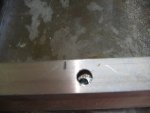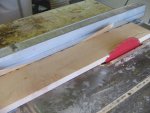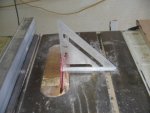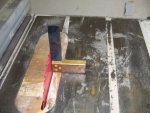- Messages
- 11,417
A few weeks ago I did an evaluation of a thin kerf glue ready rip blade by Freud in this thread.
Well that well and good if you are starting out with board that are straight to begin with but if you get a crocked one you have to go to the joiner and then what good is the blade. What I do and it works well is take a piece of 1 inch square alum tubing and place it on the bowed edge.
 I attach it with screws and then shim between the aluminum tubing and the wood.http://familywoodworking.org/forums/attachment.php?attachmentid=47112&stc=1&d=1279066992,
I attach it with screws and then shim between the aluminum tubing and the wood.http://familywoodworking.org/forums/attachment.php?attachmentid=47112&stc=1&d=1279066992,
 I have a good edge to reference from and can get quality glue line edges.
I have a good edge to reference from and can get quality glue line edges.
 I bought two 8 foot pieces cut one a 3 ft and this give me three different sizes. This is a real time saver and also if your working alone on some real long boards it is a lot easier. Also for folks just getting started using this method and making a planer sled for face joining. it can negate the need for even buying a joiner.
I bought two 8 foot pieces cut one a 3 ft and this give me three different sizes. This is a real time saver and also if your working alone on some real long boards it is a lot easier. Also for folks just getting started using this method and making a planer sled for face joining. it can negate the need for even buying a joiner.
Well that well and good if you are starting out with board that are straight to begin with but if you get a crocked one you have to go to the joiner and then what good is the blade. What I do and it works well is take a piece of 1 inch square alum tubing and place it on the bowed edge.
Attachments
Last edited:










 When your house is 100+ years old sometimes you're lucky to find parallel areas for trim.
When your house is 100+ years old sometimes you're lucky to find parallel areas for trim.